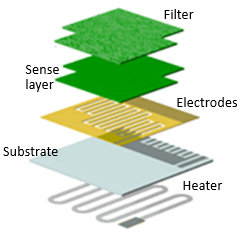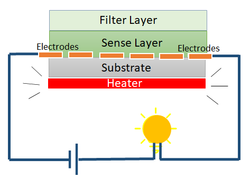Technology
Compared to alternative gas sensing technologies, MOx sensors offer low-cost, long lifetimes, miniaturization and can operate in hostile environments.
The sensor is basically a multi-layered chip, orchestrated by the sense layer 'brain', changing conductivity in sympathy with localised environmental changes.



Some of the known downsides such as drift, cross-sensitivity, and the need to heat the sensors, limit overall uptake to undemanding opportunities.
By and large, habits of MOx companies operate along the following lines:
- use of easily fabricated sensing materials (e.g. SnO2) but behaviour-wise fickle
- high reliance on opaque correction algorithms, delivering a 'synthetic' signal
- offer total VOC sensors which are used as proxy or poor man's CO2 sensors
They could do better but the end applications are unregulated, highly cost-sensitive but quite undemanding in performance. Saying you have a VOC sensor onboard seems to carry the day!
Building on our back catalogue of materials know-how, we are pioneering innovative approaches, particularly:
- Challenging the current approach of suspect-materials-plus-opaque-algorithms
- Introducing totally new & reliable gas-sensing materials
- Smartening the crude VOC sensors via self-diagnostics & discriminating ability
- Providing real not proxy measurements
- Offering gas speciation to challenge FAIMS, GC-MS & other separation methods
Examples of our disruptive* approach include:
VOC sensors which instead of a crude measure of indoor air quality, distinguish between benign and harmful VOC species, providing an informative measurement. More info …
CO2 sensors which means MOx sensors can outcompete the costly, bulky and restricted use alternative technologies.
More info …
p-type sensors which give superior performance to n-type, requiring minimal data processing. More info …
Low-power ceramic sensors offer simpler business models and superior technical performance to silicon MEMS based sensors. More info …
* Overused term, but used here as a business concept in line with characteristics described by recognised business academics C. M. Christensen & J. Gans

